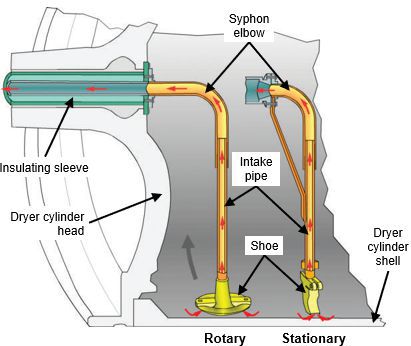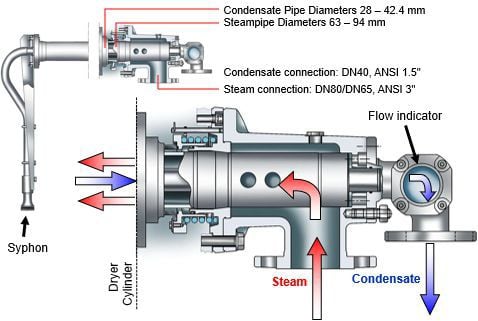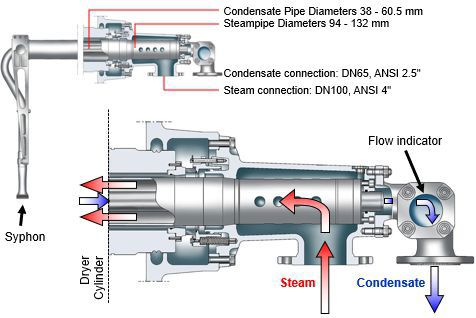Troubleshoot dryers and steam & condensate systems, part 2
Mar 15, 2022
Dryers and steam & condensate systems involve a complicated set of interdependent process values. Changes to one variable cascade to other variable changes. The following are some notes on overall troubleshooting and operations of steam and condensate systems in the mill. A previous Up & Running article presented tips for troubleshooting your dryer section.
The temperature of dryer can surfaces is a key measure of overall system efficiency. Trend the steam and dryer can surface temperatures down the machine to find where there is inefficient transfer of energy from steam to the dryer can surface. This can indicate condensate removal problems at high differential temperature. The temperature difference should not be greater than 40-50 °F. Can-to-can temperature differences should not be greater than 5-10 °F. Can cause sheet flutter due to inefficient drying.

A rotary (left) or stationary (right) syphon removes condensate from the inside surface of the dryer cylinder shell.
Sheet temperatures define the drying curve of the machine. The sheet temperature should increase slowly to reduce picking and cockling in the early cans and sheet flutter later. High sheet temperature early in the section can indicate high pocket humidities (less evaporation and higher temps). Low sheet moistures going into early in the section can also indicate high pocket humidities (less evaporation and higher temps). Low sheet moistures going into the size press are caused by too many cans operating in the "falling drying rate zone", resulting in high can and sheet temperatures.
Vent valves to the condenser or atmosphere should normally be closed. Open valves are an indication of operating problems.

Valmet Steam and Condensate Unit S (replaces DriCompact)
Condensing load in a section can be calculated by measuring the production rate, inlet and outlet sheet moisture, and heat added by dryers:
- Heat used to evaporate water in sheet (~985 BTU/lb). Fixed by sheet temperature, highest heat load in dryer system.
- Heat used to bring sheet fiber and water to evaporation temperature.
- Heat to bring the sheet from evaporation temperature to exiting temperature.
- Heat lost to radiation of dryer can surface and heads (minor compared to other types of heat).
- Heat lost from sheet and dryer fabrics (minor compared to other types of heat).
- Condensing load can be lower where there are high pocket humidities. Measure sheet temperatures and humidities.
- Unfelted or partially unfelted cans will be less effective at transferring heat to the sheet. Surface temperature will be close to steam saturation temp.
- Top uniruns have high condensing loads due to high wrap and cooler sheet temps coming in.
- Spoiler bars increase condensing load.

Valmet Steam and Condensate Unit L (replaces DriCombi)
Condensing load and blowthough determine siphon and condensate line size. Blowthough about 15-20% of condensing load and enough to guarantee removal of condensate from the can. The amount of blowthrough is affected by:
- Siphon size: too small means not enough blowthrough to remove condensate and too big means too much blowthrough for condensate and steam TC's.
- Size and configuration of condensate line / steam line: max pressure drop to condensate line should not exceed O.5 psi.
- Steam pressure: low pressure, high volume steam flows to early dryer cans can create high pressure drops in lines. Pressures should be graduated down the machine. The first dryers after unoruns should also be controlled lower as the sheet will tend to stick to it causing release problems. Also, pockets may be very humid as trapped water is released from the wire side of the paper.
- Thermocompressor sizing: motive steam nozzlev vs. blowthrough throat size need to be correct to ensure adequate control.
- Size of steam joint.
- Differential pressure from inlet to outlet header.
- Condensing load and machine speed.
A flooded dryer will stay flooded until the dryer section is shutdown and cleared.
For assistance troubleshooting your dryer section and steam & condensate sytems, contact your Valmet representative.